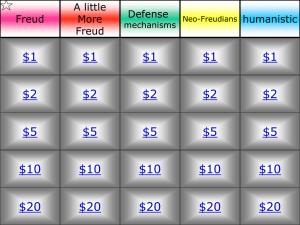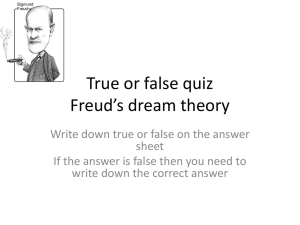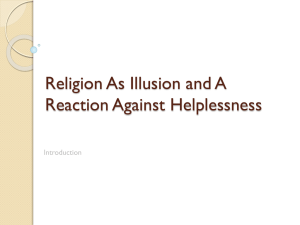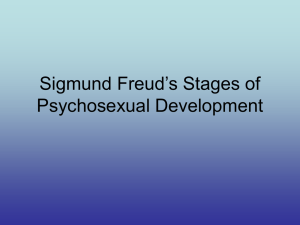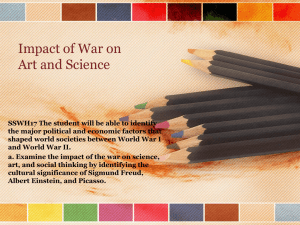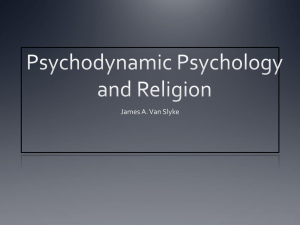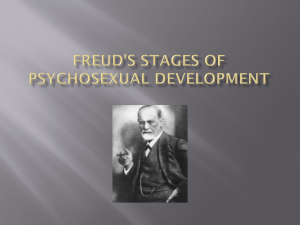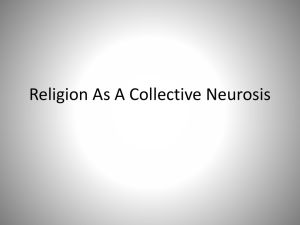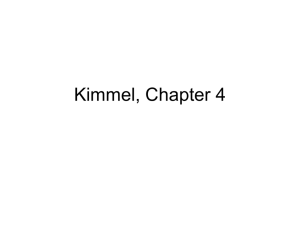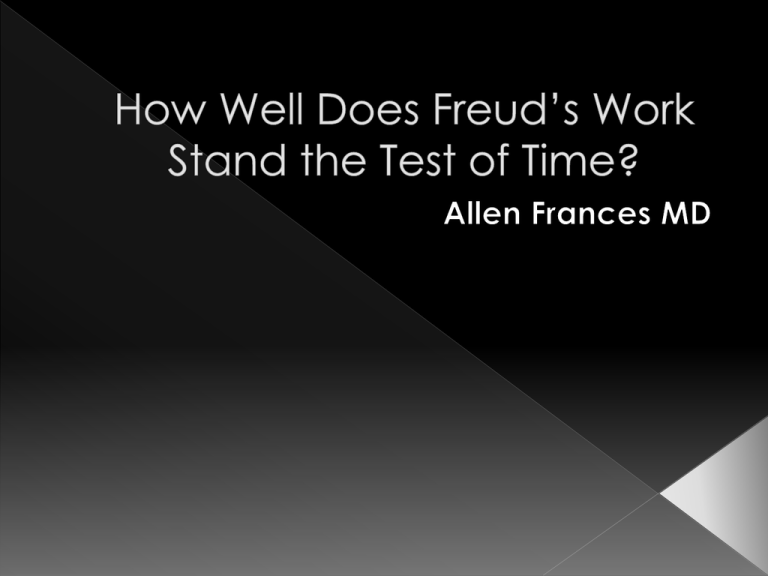
Freud
Neuroscience
Cognitive psychology
Computer science
The social sciences
Art criticism
Philosophy
Intellectual history
› I know almost nothing about everything and
welcome contributions from the audience on all
of these topics
Complete model links brain and mind
Science and humanities
Medicine with evolutionary biology
Normal and abnormal psychology
Individual and group psychology
Past, prehistory, and modern cultures
Mind can be studied scientifically
UCS determines much of what we do
Role of defense and psychic conflict
Bridge: Darwin to everyday life
Precursor of evolutionary psychology
Epigenesis, not degeneracy or genetics
The Kraepelin of outpatient diagnosis
Father of all modern talk therapies
All speak Freud without knowing it
Furthers modernism, individualism, fem
emancipation, and sexual revolution
Embraced by intellectuals in their
opposition to Hapsberg status quo
regarding church, politics, bureaucracy,
and morality
But unlike Adler, Reich, Fennel, From, and
Marxists, Freud was pessimistic regarding
changing human nature and society
M and N Notebooks (1838-1840)
On the Origin of Species (1859)
The Descent of Man and Selection in
Relation to Sex (1871)
The Expression of the Emotions in Man
and Animals (1872)
Biographical Sketch of an Infant (1877)
Human psychology from animal and
retains much of our inheritance
Understanding baboons tells us more
than reading Locke and the philosophers
Psychology can be an objective science
amenable to observation and
experiment
Materialist mind as a brain function: no
vitalism or human exceptionalism
Natural and sexual selection lead to
evolution of instincts, emotions, and
intellect
UCS-major rule influencing behavior
Instinct interacts with environment
The child is father to the man
Everything has or once had a purpose
Compare animal and human behaviors
Survey human behavior around the
world
Minute observation of child maturation
Reactions to facial expressions
Introspection and dream analysis
Neither invented idea
› By 1700 UCS conceivable
› By 1800 UCS topical
› 1870-1880 UCS fashionable
Darwin’s UCS is mostly adaptive, nonconflictual reflection of evolution
Freud adds dynamic unconscious-conflict
between lusty instinctual wishes and
repressive forces, some inborn
Hartmann adds conflict free sphere
Darwin entry point is normal function;
Freud’s is the study of psychopathology
Darwin optimist; Freud pessimist
Darwin hates conflict; Freud relishes
Darwin establishment; Freud outsider
Darwin inborn moral sense to be good;
Freud inborn punishing superego
Darwin cherished fruits of civilizing; Freud
saw it as discontents
Helmholz-brain; as electrical machine;
see with out brains, not just our eyes
Meynert, Jackson- hierarchy of brain
structure and fx; inhibition and regress
The sexologists: Moll, Ellis, Kraft-Ebbing
Archeology-dig for deeper UCS layers
Anthropology-universals in UCS content
Plato-reality under world of appearance
Kant-limits of reason and perceptions
Schopenhauer, Nietzche, Herbart,
Hartmann- UCS sexual and aggressive
forces influence behavior
Deductive model building not experimental
model testing
A beautiful speculative model must be trueeg humoral, string, neurotransmitter
Becomes dogma-number of horses’ teeth
Freud an exquisite logician-errors come
from false premises, not weak argument
Metapsychology is not a science-closes off
refutation and inclusion of new data
Appeal to authority impedes progress
Lack of validators promotes schisms
Sophocles
Bible
Shakespeare
Goethe
Dostoevski
Bridges gap between brain materialism
and psychological romanticism
Breath-brain anatomist, clinician,
psychologist, anthropologist, art critic
Intellectual ambition-linking symptoms,
personality, dreams, myths, literature
Smartest person in room-not always right,
but never wrote or said a dull thing
No one idea entirely new-UCS in the air,
two books in Vienna in 1890’s; sexology
was hot new science
But brilliant in putting it all together in one
integrated and plausible model
Literary gifts- reaches general audience
and leaders of all academic disciplines
Talmud: We don’t see things as they are,
we see them as we are
Kant/Comte: Beware observer biasimpossible to remove subjectivity
Relation of observer to the observed
› Umpire 1: Call them as they are
› Umpire 2: Call them as I see them
› Umpire 3: They don’t exist till I call them
Subjectivity and projection
Circular reasoning-sought confirmations
of theories that could not be disproved
Descriptive reified as explanatory
If you disagree, must be your neurosis
Small n study-20 hysterical patients
Contempt for statistics and experiment
Subjective: Darwin looked as babies,
studied primitive men, Freud inferred
secondhand from reconstruction
Focused mostly on intrapsychic lifedownplays interpersonal causes
Ignores great role of suggestion in theory
confirmation and treatment cures
Moll- ‘Freud’s theory accounts for clinical
hx; histories don’t prove the theories’
Inheritance of acquired characteristics
Freud: “I inherited the defiance of our
ancestors defending the Temple”
Breuer: “Freud is a man given to absolute
and exclusive formulations”
Fleiss: “The reader of thoughts reads his own
thoughts into other people”
Liepmann: “Ingenious artist of thoughts
triumphs over the scientific investigator”
Bleuler: “Prickly skin-for or against us”
Jung: “One repays a teacher badly if one
remains only a pupil”
Freud: “The goody-goodies are no good
and the naughty ones go away”
Breuer: UCS/talking cure/catharsis
Fliess: infantile and bisexuality
Jung: UCS complexes/myth
Stekel: death instinct
Adler: aggression/mastery/ego psych
Groddeck: the ID
Rank: signal anxiety/separation
anxiety/termination/mother transference
Ferenczi: transference/countertransferen
Alexander: correction emotional
experience
Reich: analyze character resistance first
No coherent psychology of femininityFreud’s boy’s eye view of girls
Castration complex, penis envy, clitoris vs
vagina, masochism, passivity
Conventional views of women as
neurotic, irrational, undeveloped men
Object of desire, not subject of empathy
Downplays role of mother/child bonding
Horney- much fuller female psychology
His influence greatly liberated women
Encouraged female analysts
Strongly influenced by women
Better father figure to female followers
Neuron-cell body plus fibrils
Importance of contact barrier
Mediating vs. moderating synapses
Evolution: neurons similar across all
species-crab, lamprey, mammal
Development in pups, kittens, fetus, kids
Cells migrate and connections get more
complicated, but early structures persist
Gold chloride stain-reported in brain
Types of neurons-Phi for perception, Psi
for memory, Omega for Cs
Ambition thwarted-how to be great
when funding is lost and want to marry?
Viennese dim view of clinical practice
Virchow- “the academic physician can
do nothing; the practitioner knows
nothing”
Solution-apply scientific, observational,
theoretical, literary skills to achieve
greatness for clinical not lab work
Agnosia- deficits with intact perception
Cerebral palsy
Aphasia
Cocaine as psychotropic drug
Translates Charcot and Bernheim;
practices and writes on hypnosis
Collaborates with Breuer and has
specialty practice focused on hysteria
Attempt to transcend cathartic and
suggestion models for psychotherapy
Free association to provide a study tool
based on faith in psychic determinism
Early-misled by simple Koch causality
Into a series of blind alleys
› Inborn degeneration
› Current sexual frustration
› Early sexual seductions
Stimulation by caretakers
Stimulation but only by father
Repression of inborn sexual instinct
Later-complementary epigenetic
interaction of instinct with experience
Excitement regarding Darwin sexual
selection
Sexology brings scientific legitimacy
Staging explains choice of neurosis
Libido is missing link mediating brain
biology and mental functioning
Interaction nature/nurture
Conflict over instinctual wish fulfillment
seems to explain everything
Brain as hydraulic power plant
Sexual libido is power source
Symptoms due to discharge, build-up, or
transfer of libidinal energies
› Neurasthenia-too much masturbation
› Anxiety-toxic undischarged stimulation
› Neuroses-psychic conflict/repression
Autoerotic stage-schizophrenia
Narcissistic stage-delusional disorder
Oral stage-depression
Anal stage-obsessive/compulsive
Phallic stage-hysteria
Regressions
Fixations
Repressions in neurosis
Expression in perversions
Also determine character
Premature closure/incomplete facts
Deductive theory of everything
Way too rigid-everything is sex instinct
Ignores other instincts-aggression,
attachment, status, mastery, altruism
Ignores neural network dysfunctions
Ignores context/interpersonal issues
Freud’s humoral theory
Brain as computer
Information processing, not energies
Symptoms the result of hardware and
software malfunction
Kant and Schopenhauer-dreams as brief
madness/madness a long dream
Freud-mind a creative dream machine
Insights from dreams explain not only
symptoms but myth, art, literature, and
psychopathology of everyday life
Allow scientific study UCS process
Reflect lawful connections of all mental
functioning-nothing is random
Instincts less repressed revealing primary
process and contents of UCS
Free association to interpret content and
determine latent content
Associations may be secondary elaborations,
not key to latent content
Dream may be no more that Rorshach
No gold standard for interpretation
Wish fulfillment-random pontine firings?
Dreams tell us a lot, but not everything about
human nature
Still a mystery
We now know when dream, but not why
Role in memory/homeostasis
Borrowed from Fechner, Jackson, Darwin
CS tip of iceberg; most behavior UCS
Different rules govern different levels of
psychic functioning
Freud adds method of study, instinct,
regulation by censor, primary and
secondary process
Stands up well to modern cognitive
science and brain imaging
Self-preservative and self-evaluating
instincts in part inborn and largely UCS
General psychology that anticipates
cognitive psychology
But ego psychologists are theorists, not
experimenters, so doesn’t advance field
Useful description, not explanation
An ingenious but wrong 1890
neuroscience model that restricted its
openness to including emerging brain
and cognitive science
Freud somewhat corrects imbalance
with aggression and the “I” and the “It”
Followers extend further with attachment
theory, ego psychology, role of
interpersonal factors, conflict free
Brain too complex for simple models
Newton: “I can calculate the movement
of stars but not the madness of men”
No Newton, Darwin, or Einstein of mind
Ambition spurs insights-but premature
models can’t possibly answer all
questions and don’t wear well
ID- limbic system/brain stem
I-dorsal prefrontal/somatosensory
Over I-ventromedial frontal
Anxiety-amygdala
Psychotherapy change brain fx-reduced
amygdalar firing in panic pts
Cortical control-can’t decondition
amygdalar responses unless cortical
connections intact
Mirror neurons explain empathy for
other’s emotions-inferior front gyrus
connected to amygdala via insula
Rat maternal behavior influenced by
childhood nurturing experiences-methylation
changes gene expression
Low MAOA 80% rate ASPD if abused as child;
20% not abused
As Freud predicted, it is interacting/modulated
networks not isolated regions
Search for how connections work: NIMH RDOC
Very rapid decline from cultural icon of
hope/modernism/sexual revolution to
quaint psychological charlatan
Tipping point in 1970’s
Psychoanalysis disappoints-Berthe P:
“Psa like confession depends on person
applying it-useful or double-edged
sword”
Institutes freeze rather than adapt-other
more practical therapies prevail
Too tied to specific medical rx, not to
broader cultural and intellectual trends
Neuroscience tools lead to reductionism
Pharma adverts-chemical imbalance
Novelty wears off-once brilliant insights
seem like tired cocktail clichés
No interest in cognitive or brain science
Standardize theory and method
Closed and rigid religious cults
Indoctrination stifles incorporation of new
science/new ideas/new therapies
Secret committee/loyal tests/”treason”
Was the Project central or blind alley?
Jones-Freud was a psychologist, cutting
psychoanalysis off from neuroscience
Revisionist version emphasizes biology,
and some biologists now embrace Freud
Freud was reformed lab-rat would have
loved and incorporated neuroscience
Not a research tool
Not a practical therapy
Not a modern model of the mind
Embalmed Freud to save him
When it is incorporated into cultural
studies in other disciplines
Stays open to new ideas, finding, and
techniques
Was previously less dominant
Freud was overvalued in his own time as
a lone pioneer with final answers-but not
lone and no final answers
Freud is undervalued now because his
followers were too dogmatic to keep
psychoanalysis lively and relevant
Opens up science of UCS vs. Compte
cognitive and neuroscience behavioral
economics, sociology
Treatment insights:
›
›
›
›
›
Optimism
Value of life narrative
Role of psychic conflict
Transference/repetition compulsion
Corrective emotional experience
Art and literary criticism
Einstein
Darwin
Marx
Freud
Made inspired guesses
Brain complexity still defeats powerful
modern tools
Evolution, atomic theory, history are less
complicated than human behavior
Valued psychoanalysis more for research
than therapy-would back brief dynamic
and cognitive therapies
No problem with medication treatmentfor better and worse a pioneer
Not surprised psychoanalytic and
medical professions don’t mix well
Would Freud’s biggest weaknesses
(dogmatism, epistemology, experiment)
be cured by long sleep? Would need a
good analysis
Partly the subjectivity of subject matter
Partly Freud’s autocratic personality
Partly relation of theory to professional
guilds
Mostly issue of experimental validation
Mytheopoesis of everyday life
Interior monologue
Gave people permission to be
complicated and conflicted
Glory of individual
His ideas deserve better follow-up
His dominance prevented the inclusion
and adaptation to new data

